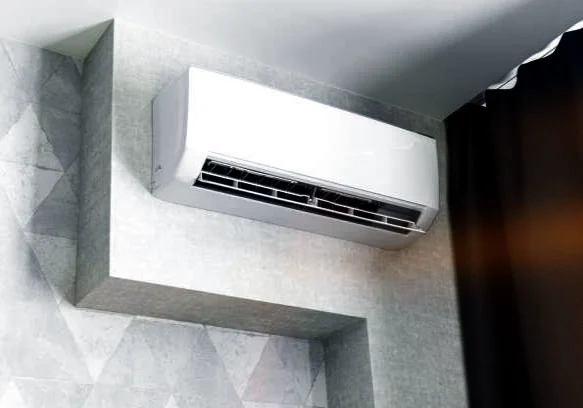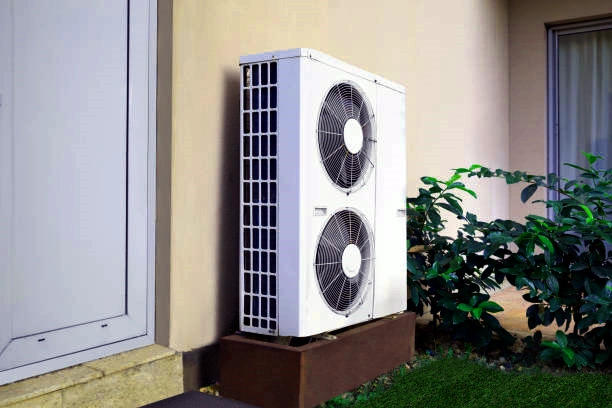How Does Ductless Mini Split Work and Why You Should Consider One?

A ductless mini split works by swapping heat between its indoor and outdoor units using a fluid known as refrigerant. This transfer method makes these systems highly efficient while providing both heating and cooling. Contrary to common belief, the equipment can extract heat even from cold outdoor air and bring it inside, creating a warm environment. This feature makes them unique and provides an unexpected benefit: efficient heating during chilly seasons. Now let’s dive deeper into how ductless mini splits work!
How a Ductless Mini Split Operates
Ductless mini-splits, much like traditional central air systems, work to maintain your home’s comfort throughout the year. However, what sets them apart is the absence of ductwork and their ingenuity in transferring heat between indoor and outdoor units.
These systems consist of two main components: an outdoor compressor or condenser and an indoor air-handling unit. The refrigerant circulates between these two units, absorbing heat from the indoor air in cooling mode and releasing it outside. In heating mode, the refrigerant absorbs heat from the outdoor air and releases it inside. This process is made possible through the principles of thermodynamics, where heat naturally moves from a place of higher concentration to one of lower concentration.
Control over this heat transfer is facilitated by an expansion valve that regulates refrigerant flow based on system demands. What makes mini-splits more efficient than traditional HVAC systems is their ability to regulate each zone individually. This level of control means you can customize temperatures throughout your home, ensuring comfort and energy savings.
The Role of Heating and Cooling in Ductless Systems
Ductless mini split systems offer both heating and cooling benefits, making them incredibly versatile. Let’s explore how this process works in more detail.
When it comes to ductless systems, the key is the heat exchange process, which allows for efficient and effective temperature regulation within your living spaces.
In cooling mode, the indoor unit uses refrigerant to absorb heat from the room, effectively siphoning off warm air from inside your home and expelling it outdoors, ensuring a cool and comfortable living space even on the hottest summer days.
On the other hand, when the system operates in heating mode, it reverses this process by drawing in heat from the outdoor air and transferring it inside. This means ductless systems are adept at efficiently heating your space, even during colder months.
Energy Efficiency and Comfort
One standout feature of ductless systems is their exceptional energy efficiency. Unlike traditional HVAC units that often waste energy cycling on and off to maintain consistent temperatures, ductless systems use inverter technology to adjust compressor speed based on the system’s requirements, resulting in significant energy savings compared to standard systems.
Moreover, the individually controlled zones provided by ductless mini splits allow for custom temperature settings in different areas of your home, ensuring personalized comfort for all occupants. This zoning capability is unbeatable when compared to central air systems, as it gives you complete control over each room’s climate without compromising on energy usage or comfort levels.
In addition, the process of moving heat rather than generating it from scratch makes these systems even more efficient. By leveraging existing thermal energy, they amplify their impact while minimizing energy consumption—a true win-win situation.
By understanding the significant role of heating and cooling in ductless systems, you can see why they are a compelling option for maintaining a comfortable living environment with minimal energy usage. Their ability to efficiently regulate temperature while offering customizable comfort is truly remarkable.
Understanding Air Flow in Ductless Mini Splits
One of the key factors that makes ductless mini-splits so efficient is the way they handle air flow. When you turn on your mini-split system, the warm air from inside the room is drawn into the indoor unit. As the air passes over the unit’s evaporator coil, something pretty amazing happens. The refrigerant inside absorbs the heat from the warm air, effectively cooling it down before sending it back into the room.
To put it simply, it’s like experiencing a cool breeze on a warm day outdoors. The faster-moving air helps draw away some of your body’s heat, leaving you feeling cooler. Similarly, in a mini-split system, as the warm air passes over the evaporator coil, it gives off its heat to the refrigerant, which then cools the air before releasing it back into the room. This simple but effective process is what makes it possible for you to maintain a comfortable indoor temperature.
Consider your indoor unit as a kind of magic box that takes in warm air and turns it into cool air, almost like clockwork. Whether it’s summertime and you need relief from the sweltering heat or winter when you want to stay cozy and warm, this process can be fine-tuned to keep your indoor climate exactly how you want it.
Unlike traditional HVAC systems that blast out air at full capacity and then shut off once the desired temperature is reached, ductless mini-splits are designed to maintain consistent temperatures by continuously adjusting their output. This means they work smart, not hard, to ensure your comfort while being energy-efficient.
How do they achieve this? Well, these systems use a technology called “inverter-driven compressors” that adjust their speed according to the temperature needs of your space. Essentially, they slow down or speed up based on how much heating or cooling is required, keeping your room at a consistent temperature and minimizing energy waste.
Examining Ductless Mini Split System Parts
Ductless mini split systems consist of several key components that work in harmony to deliver efficient cooling and heating. Understanding each part can help you grasp how these systems provide comfort while remaining energy-efficient.
First, let’s talk about the outdoor unit. This is a crucial part of the system as it houses the condenser, compressor, and fan. The condenser coil releases or collects heat, depending on whether you’re using the system for cooling or heating. The compressor acts as the heart of the operation; it pumps refrigerant through the system to transfer heat. Finally, the fan works to dissipate heat absorbed by the refrigerant.
Indoor Unit
Moving indoors, the indoor unit comprises the evaporator coil and a blower fan. The evaporator coil absorbs heat from the room, and the blower fan distributes cooled air back into your living space. This combination ensures efficient and even cooling, regardless of where it’s installed.
These components are vital for efficient and balanced temperature control within individual rooms, showcasing one of the key advantages of ductless mini split systems—integrated zoning.
Next, consider the refrigerant lines that connect the outdoor and indoor units. These lines carry refrigerant back and forth between the two units, managing heat exchange to achieve the desired temperature. It’s crucial to ensure that these lines are properly insulated to maintain efficiency and prevent any loss of thermal energy during transportation.
To keep everything running smoothly, there’s a conduit in place. This conduit houses both the power cable and refrigerant tubing, as well as suction tubing for drawing air into the indoor unit and a condensate drain for removing excess moisture produced during operation.
In summary, each part plays a vital role in maintaining a comfortable indoor climate while utilizing energy efficiently. By understanding these components, you can appreciate the sophistication behind ductless mini split systems and how they contribute to a more comfortable living environment while ensuring energy efficiency.

Examining the Indoor Unit of a Mini Split: An Inside Look
The indoor unit of a ductless mini split system is where the magic happens. Let’s take a closer look at each component:
The Evaporator Coil
The evaporator coil is the unsung hero of the air conditioning process. When hot air is blown over the evaporator coil, it absorbs heat from the air, cooling it down in the process. This cooled air is then circulated back into the room, creating a comfortable indoor environment. This process occurs thanks to the refrigerant inside the coil, which undergoes a phase change from liquid to gas and back to liquid, constantly absorbing and releasing heat along the way.
This phase change allows the evaporator coil to cool down the air without increasing its power consumption. It’s like a tiny, efficient heat exchanger hidden within your indoor unit. The meticulous construction and placement of the evaporator coil make it an essential part of the mini-split system’s cooling process.
Air Filters
Air filters play a crucial role in maintaining good indoor air quality. They trap dust, allergens, and other particles, preventing them from circulating in your home. It’s like having a shield protecting you from harmful particles, ensuring that the air you breathe is clean and healthy.
By regularly cleaning or replacing these filters according to the manufacturer’s recommendations, you can ensure that your indoor unit continues to provide clean, fresh air and operates at peak efficiency.
Dirty filters can lead to poor indoor air quality and diminish your unit’s performance over time.
The Fan
The fan inside the indoor unit is responsible for blowing air over the evaporator coil. It facilitates the heat exchange process by drawing warm air from inside your home and passing it over the cold evaporator coil before distributing the cooled air throughout the room.
Control Panel
The control panel is like the brain of your indoor unit. It allows you to set and adjust temperature settings, fan speed, mode of operation (cooling or heating), and other functions. Some advanced models even offer Wi-Fi connectivity for remote access and control via smartphone apps—imagine being able to adjust your home’s temperature while you’re out and about!
Understanding how each component works independently within the indoor unit gives us better insight into how they come together harmoniously to keep your space comfortable in any season.
The Function and Design of a Mini Split’s Outdoor Unit
An often-ignored part of ductless mini-split systems, the outdoor unit works tirelessly to keep your house at the perfect temperature. It houses critical components such as the compressor, condenser coil, and fan – each playing a vital role in the efficient functioning of the system.
The Compressor: Powering Refrigerant Circulation
Sitting at the heart of the outdoor unit, the compressor serves as the powerhouse that pressurizes the refrigerant gas, setting it up for its journey into the indoor unit. Think of it as the engine of the whole operation, transforming the low-pressure gas returning from the evaporator in the indoor unit into high-pressure gas ready to release heat and start the cooling cycle anew.
The Condenser Coil: Dissipating Heat
Adjacent to the compressor, you’ll find the condenser coil – an indispensable element responsible for dissipating the heat extracted from inside your home. As the high-pressure refrigerant gas flows through this coil, it sheds its heat energy into the outside air. This process marks a crucial transition point in the refrigeration cycle, where the gas transforms back into a liquid state before heading back indoors to repeat its chilling duties.
The Fan: Assisting Heat Release and Air Circulation
Completing this ensemble is an integral partner in thermal exchange—the fan. Positioned to facilitate quick heat dissipation and encourage smooth airflow, it expedites the release of warmth accumulated from the inside. Additionally, it aids in propelling cool air into your living spaces and maintaining an optimal temperature distribution.
By understanding how each component in the outdoor unit performs a specialized task with precision and synergy, you gain insight into why ductless mini splits are renowned for their energy efficiency and consistent climate control capabilities.
Understanding these outdoor components provides assurance that your comfort needs will be expertly met while also saving on energy costs when considering a ductless mini split for your home.
The Advantages and Disadvantages of Ductless Mini Splits
Ductless mini-split systems have several advantages that make them a compelling option for many homeowners. Let’s explore these advantages first.
Advantages
- Easy Installation: Traditional central HVAC system installations can be disruptive, requiring extensive ductwork. In contrast, ductless mini-splits are easier to install due to their simpler components and the absence of ducts, making them suitable for renovations or additions without expanding existing ductwork.
- Energy Efficiency: Ductless mini-splits deliver conditioned air directly to individual rooms, avoiding the energy losses associated with ductwork in traditional systems. This targeted approach can lead to significant energy savings over time.
- Zoning Capabilities: Ductless mini-splits feature built-in zoning capability, allowing for individualized climate control in different rooms or zones. This level of customized temperature regulation enhances comfort and energy efficiency.
- Quiet Operation: Unlike many traditional HVAC systems, ductless mini-splits operate quietly, making them an ideal choice for spaces where noise levels need to be kept at a minimum.
Now, while ductless mini-splits have numerous advantages, it’s important to consider the potential drawbacks as well.
Drawbacks
- Higher Initial Costs: The upfront cost of purchasing and installing a ductless mini-split system can be higher than that of traditional HVAC systems. However, the long-term energy savings may offset this initial investment.
- Regular Maintenance: Like any HVAC system, ductless mini-splits require regular maintenance to ensure optimal performance. While this may be seen as a downside by some, regular maintenance is necessary to prolong the system’s lifespan and maintain its efficiency.
It’s important to weigh the pros and cons when considering a ductless mini-split system for your home. Despite potential drawbacks such as higher initial costs and required maintenance, the benefits of easy installation, energy efficiency, zoning capabilities, and quiet operation often outweigh these concerns.
Final Words
Understanding the science of ductless mini splits provides clarity into their efficient operation and the various advantages they bring to living spaces. If you are seeking an energy-saving and personalized comfort solution that offers flexibility, energy savings, and personalized comfort, a ductless mini split could be exactly what’s needed. Ready to experience the benefits of a ductless mini-split? Contact us today at My Diamond Comfort or call us at (413) 527-4737 for expert guidance on finding the perfect HVAC solution for your home!
Have Any Questions?
Get in contact with us today! We are always happy to help, and you can count on our expertise.

